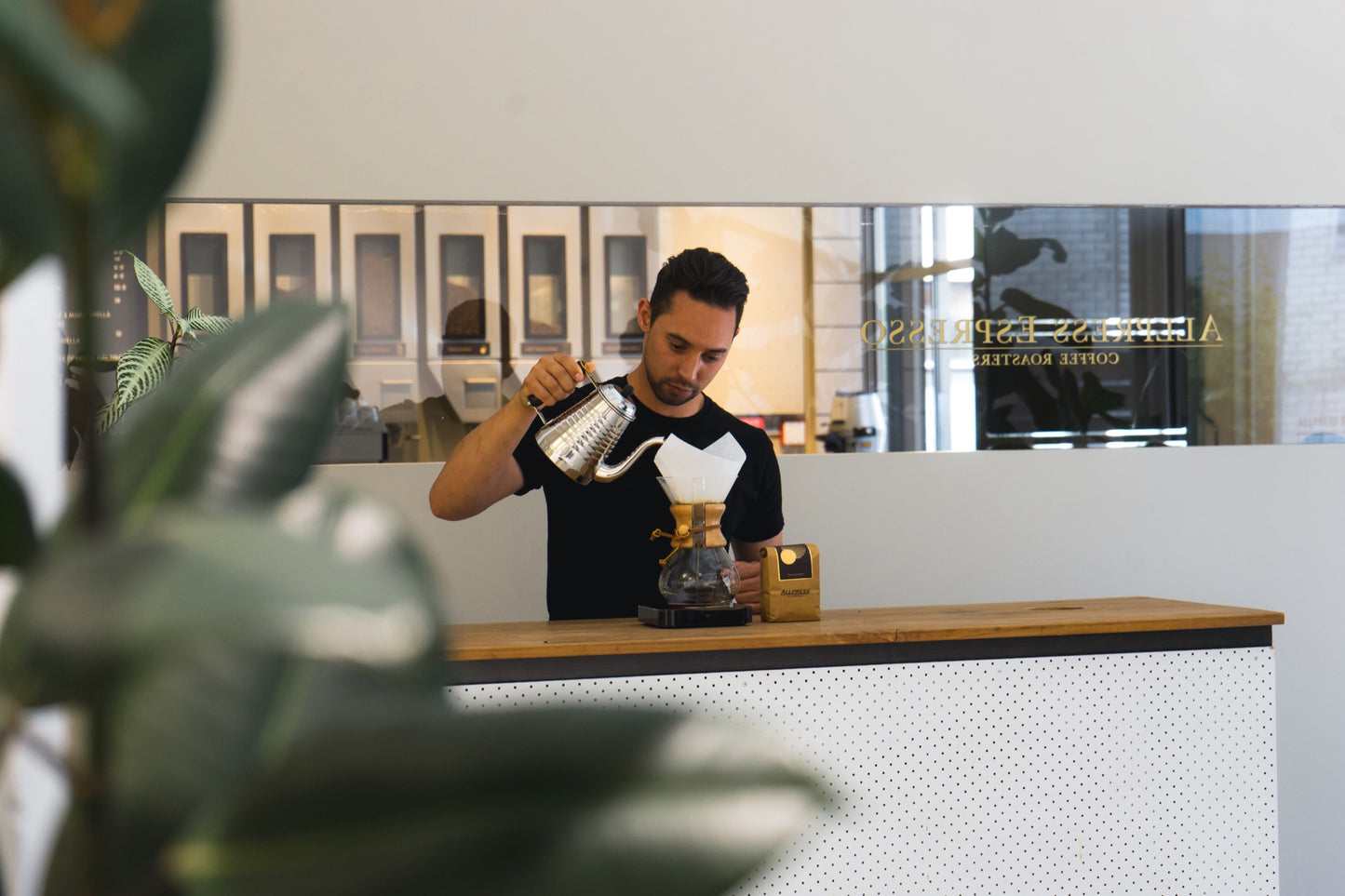
A quick history lesson - the Chemex was designed and crafted in 1941 by Peter Schlumbohm in Massachusetts. It's a classic piece of coffee equipment that in 50 years time will still look as sexy as it does now. Think open hourglass with dark caramel sand slowly streaming to the bottom, grain on top of grain forming a little Costa Rican panela sand dune... aannnd that's pretty much my interpretation of this history lesson done!
I first started brewing with the Chemex September 2015, as I began my new job at Allpress Espresso in Auckland. I was a complete rookie, I'll repeat that for emphasis, I was a complete rookie! I was winging it when it came to manual brewing on the Chemex. Having only brewed on an Aeropress, the Chemex was the second piece of manual brew gear I was exposed to. My aim was to make a really good brew and be the "go to guy" who knew absolutely everything about brewing on a Chemex. However knowing everything and being able to use that information to navigate what a good brew obtained, was something that wouldn't punch me in the face until I understood what I liked and disliked in coffee. More importantly, I needed to understand what under and over extracted coffee tasted like and how to distinguish the difference on my palate. This was in order to find that happy place towards unobtained flavours (under extracted) and zombie flavours (over extracted/RIP flavour, see you in another cup and in another life!)


What I learned using the Chemex - Brewing with the Chemex taught me two things. The first thing was the term 'flatbed' and what that means. When you hear people talk about aiming to achieve a flatbed, they are referring to the process of filter brewing when the liquid passes through the brew slurry down the carafe and what that looks like at the end of the brew. Hence the term 'flatbed'. Having a flatbed of coffee after the brew has finished tells us a bit about the coffee's journey of extraction. Water will naturally follow the path of least resistance and by aiming to achieve a flatbed you are ensuring some level of even extraction. If you see little hills/bumps or the bed ramped to one side, it could cause channelling during the brew, producing an uneven extraction and an unbalanced cup. Channelling can occur in many different filter brewing methods so its good to understand what this looks like visually.


The second and more important lesson was "If you ain't got it, don't act as if you do!" After a few months of religiously brewing on the Chemex, I learned a very important lesson from someone I still look up to this very day. His name is Mark Waitzer, Sales/Account Manager for Allpress Espresso. He was in a position I very much wanted to pursue so naturally I aspired to impress him. Long story short, I had made several Chemex brews and went around the office offering everyone a little and when I had got to Mark he questioned me on the brew, what origin it was, and if it was a natural or washed coffee? I had stood in front of him almost unable to answer. Argh! This was me pretty much blowing it! Sure I knew what coffee it was but the rest seemed unimportant to me. I was so focussed and confident in brewing the coffee that the interaction aspect flew out the window. I remember thinking to myself, "Charlie, you don't have to remember anything about this coffee, no one's going to ask you a thing! Ha!" Your brain is a funny thing and personally, I find that I remember the oddest moments as clear as yesterday. That taught me valuable lessons that at the time I didn't fully understand. I failed to think about one of the biggest aspects of coffee, people!

For some people reading this, it may seem odd that I'm getting hung up on this point, but at the time it ate me up. I was so frustrated at the way it played out that I made a conscious effort from that moment forth to not only offer an awesome brew but for the brew to offer the opportunity to connect with someone. Today I keep that lesson at the forefront of anything coffee related I do. Coffee, people and balance!
The coffee I was brewing was a Brazilian coffee from Fazenda Santa Alina. I mentioned in my Aeropress feature the first fruit flavour I discovered in coffee was blueberry. Well, while brewing this Santa Alina drop I discovered other flavours for the first time like milk chocolate, caramel, and nuts. The best way to describe this coffee would be relating it to eating a Picnic Bar. Smooth milk chocolate, gooey caramel, soft nougat along with crushed peanuts, biscuits and rice puffs laced throughout the bar, offering this textural journey that together builds a lingering moreish aftertaste. I don't know about you but I'm licking my lips right now! The only thing the coffee offered that the bar doesn't possess was a mild apple acidity. I was hooked on brewing this coffee, no wild fruity flavours, no cartwheels, no fireworks, just a ridiculously delicious brew! People give Brazilian coffees a hard time but I still enjoy those simple comfort flavours. Recently, I've been drinking some wildly fruity Brazilian coffees that have been amazing but nothing beats those nostalgic flavours that remind me of my introduction to the Chemex.


Fast forward to now and I actually haven't changed much of how I brew on the Chemex. I tend to approach it in a thoughtful way, like using a lot of water when rinsing the filter paper, as it's much thicker compared to let's say V60 filter papers. Because the paper is thicker and there's more of it, I want to ensure it gets a good rinse which also allows me to eliminate as much of that papery taste as possible. If you've ever used the unbleached brown Chemex paper filters, it's as though you're licking a piece of cardboard, and that taste is like glue on your tongue. It's going to stick around for a little while, yummy!!! Oh, I can't wait to taste that floral, strawberry, silky milk chocolate with a hint of cardboard, HA! I also like to grind the coffee a bit coarser and I tend to start my dose at 34 grams and work up or down from there. The reason I like to grind coarser for the Chemex is that sometimes the brew can halt and drip. This could happen at the start or sometimes halfway through the brew. I haven't done any heavy research into this but I feel like its a combination of not getting the filter paper in the perfect spot within spout and having a finer grind size. This, in my experience, seems to cease the brew. Hopefully, these suggestions will improve and guide your approach to brewing on the Chemex!

My go-to 6 Cup Chemex Recipe
Dose - 34
Yield - 500g
Time - 4:30 min
Ratio - 1:14.7
Temp - 96 degrees
Grind - 27 clicks on the Comandante
Bloom - 70g, 35 seconds
Preparation
Place the Chemex paper filter with the thicker side (3 layers) on the spout side of the brewer. Rinse the paper filter with hot water. This will rinse the filter from any papery taste and heat the server at the same time!
Discard the water from the server and tare your scale to zero.
Add the ground coffee to your Chemex giving it a gentle shake to level the grounds and tare once again. You're ready to rock and roll!


Method
00:00
Start your timer, pour 70 grams of water onto your bed of coffee, ensuring all the dry grounds are completely saturated. You can achieve this by either spinning the saturated grounds in a circular motion or using a bamboo paddle to achieve the same effect.
Be careful to not over agitate, remember we only want to saturate the dry coffee. This part of the brew is called the "bloom" and it prepares your coffee for the rest of the brewing process.
00:35
In a circular motion pour 130 grams of water slowly, concentrating your pour near the edges of the pool but not on the filter.
01:30
In the same manner, continue to pour a further 300 grams of water into your pool of coffee.
04:00
Pick the Chemex up safely (be careful as it gets hot!) and gently tap on the bench. This allows the final stages of brewing to flow smoothly and usually results in a flatbed.
04:30
Once the brew reduces down to a drip, remove and discard the filter. Dig in and appreciate that good flavour!
Note
If you find your time is noticeably slower it's a good indication that your grind size is too fine. If you brew time is really fast, it's a good indication your grind size is too coarse and it means you need to adjust your grind size finer to find the suitable size for this recipe.
Swirl it, smell it, pour it, enjoy it! 👌🏽


For more on this particular coffee, check out Allpress Espresso! ✌🏽
#SOWJUICY 🍒
